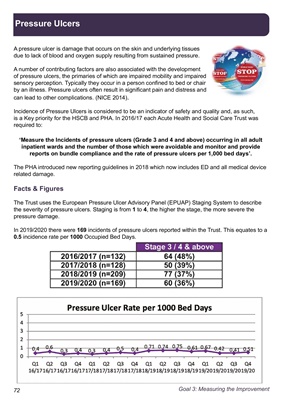
A pressure ulcer is damage that occurs on the skin and underlying tissues
due to lack of blood and oxygen supply resulting from sustained pressure.
A number of contributing factors are also associated with the development
of pressure ulcers, the primaries of which are impaired mobility and impaired
sensory perception. Typically they occur in a person confined to bed or chair
by an illness. Pressure ulcers often result in significant pain and distress and
can lead to other complications. (NICE 2014).
Incidence of Pressure Ulcers is considered to be an indicator of safety and quality and, as such,
is a Key priority for the HSCB and PHA. In 2016/17 each Acute Health and Social Care Trust was
required to:
'Measure the Incidents of pressure ulcers (Grade 3 and 4 and above) occurring in all adult
inpatient wards and the number of those which were avoidable and monitor and provide
reports on bundle compliance and the rate of pressure ulcers per 1,000 bed days'.
The PHA introduced new reporting guidelines in 2018 which now includes ED and all medical device
related damage.
Pressure Ulcers
Facts & Figures
The Trust uses the European Pressure Ulcer Advisory Panel (EPUAP) Staging System to describe
the severity of pressure ulcers. Staging is from 1 to 4, the higher the stage, the more severe the
pressure damage.
In 2019/2020 there were 169 incidents of pressure ulcers reported within the Trust. This equates to a
0.5 incidence rate per 1000 Occupied Bed Days.
Goal 3: Measuring the Improvement
72